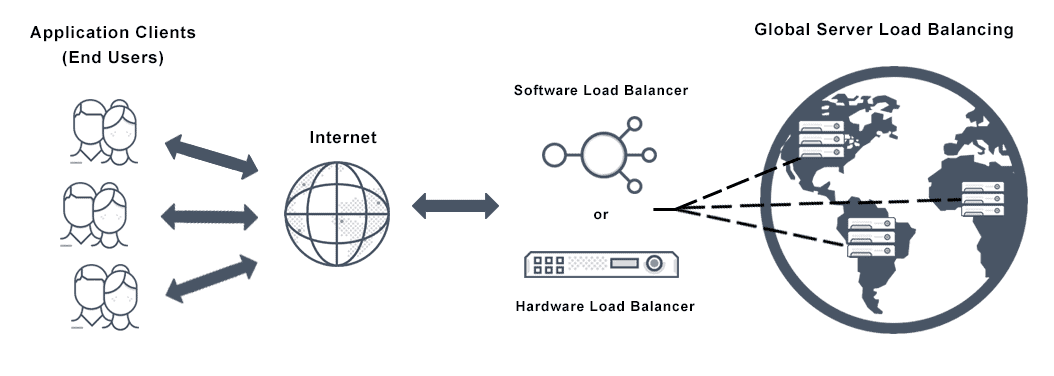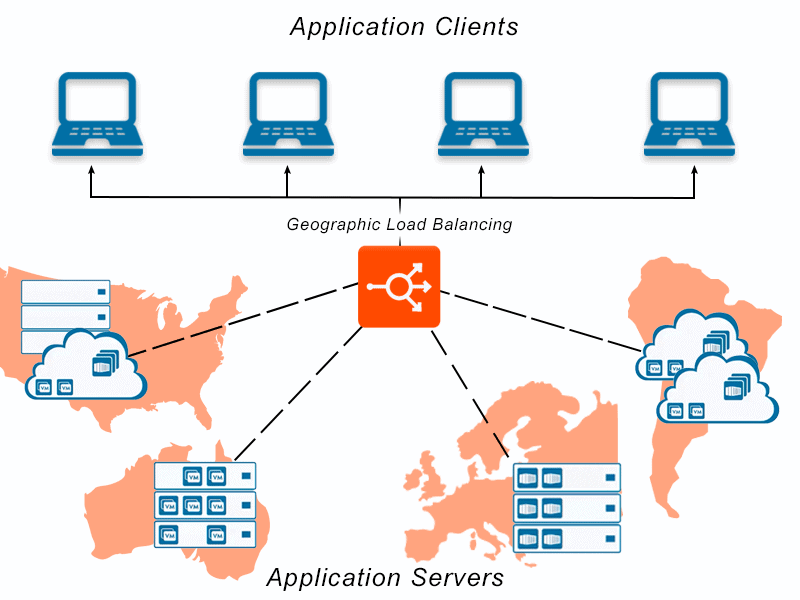Google Cloud Load Balancer Definition
Google Cloud Platform (GCP) users effectively balance workloads with managed services. Google Cloud Load Balancer monitoring distributes traffic across multiple instances of applications in a few different ways.
Google Cloud Load Balancer Types
Global Load Balancing (GLB)
Global load balancing (GLB) distributes workload traffic globally across connected server resources located in different geographical regions rather than keeping it in a single data center. Modern applications are distributed across regions, so they function better for users if a global load balancer connects servers and users that are geographically proximal.
The global version of Google Cloud computing load balancers enhance application performance with disaster recovery benefits and optimized traffic management. And in contrast to load balancing in Azure and AWS, Google Cloud computing load balancers can manage resources deployed across regions without a complex VPN or network-peering configuration.
Google Cloud Regional Load Balancer
Users split workload between servers in the same region with regional load balancing. This can allow certain niche businesses to serve customers in specific regions, for example. However, a single server may not be able to handle their workload, so these businesses cope by locating a fleet of servers near customers. Regional load balancers manage this kind of workload.
External Load Balancing (ELB)
External load balancing supports buckets in Cloud Storage, internet NEGs, managed instance groups, serverless NEGs, and Zonal network endpoint groups (NEGs). Use external load balancing to support application, web, and database tier services.
External load balancing also supports cross-region load balancing and content-based load balancing, each with managed instance groups across multiple regions. Premium Tier external load balancer features include routing traffic to the nearest Google Front End and advertising the same global external IP address from various points of presence.
Internal Load Balancing (ILB)
Internal load balancing allows applications to run behind an internal IP address and sends traffic (such as HTTP/HTTPs traffic) to the backend application hosted on Google Compute Engine (GCE) or Google Kubernetes Engine (GKE). A managed service, the internal load balancer can only be accessed on an internal IP address and in the Virtual Private Cloud network’s chosen region.
Internal load balancers deliver the load balancing service using health checks and a URL map. They can help support database tier services and web applications and improve legacy applications.
In Kubernetes in particular there is a debate between Google Cloud Load Balancer vs ingress, or really load balancing and ingress generally.
On a public cloud in particular, Google Cloud Kubernetes load balancer is best when it’s important to control exactly which ports the service uses. Unfortunately, as each service requires its own external IP address and load balancer, the costs can climb quickly on the public cloud.
Ingress in combination with Google Cloud Load Balancer for Kubernetes is now often used, because it allows every service to have a unique name and/or URI routing while minimizing the number of IPs used.
Google Cloud SSL Load Balancer
TCP/SSL (Transmission Control Protocol/Secure Socket Layer) load balancers distribute TCP traffic within a Compute Engine region across a pool of VM instances. TCP/SSL load balancers use TCP or SSL protocols that balance user SSL (TSL) connections at the load balancing layer across backend instances. It’s important to note that if you use Google cloud SSL load balancer below the premium network service tier, the load balancing becomes a regional service requiring all backend servers to be inside the region of the load balancer’s external IP address and forwarding rule.
TCP Proxy Load Balancing
The TCP Proxy Load Balancing (TPLB) is a form of global load balancing suitable for uninterrupted non-HTTP traffic when no SSL offload is needed. It is globally distributed, implemented on Google Front Ends (GFEs). TCP proxy load balancers can have backend servers in multiple regions. Acting as a reverse proxy, TCP Proxy Load Balancing distributes TCP traffic to virtual machine (VM) instances in the Google Cloud VPC network to the closest backends to the user.

Google Cloud Load Balancer FAQs
What is Load Balancer in Google Cloud?
The best Google Cloud native load balancer for a given implementation depends on the need for regional or global load balancing. Regional load balancing maintains backend endpoints within one region. Global load balancing locates backend endpoints across multiple regions.
When considering external or internal load balancing, it is the type of traffic being served that matters, such as SSL, HTTP, HTTPS, UDP, TCP, etc.
There are four external load balancing options:
- HTTP(S) load balancing for HTTP or HTTPS traffic
- TCP Proxy for TCP traffic without SSL offload
- SSL Proxy for SSL offload
- Network load balancing for TCP/UDP traffic
Many modern businesses don’t develop or maintain global load balancing solutions in-house. Instead, load balancing services such as Google Cloud Load Balancer (GCLB) have become a popular alternative.
DNS-based load balancing is the easiest and most effective way to load balance before the user has even connected. However, it relies on expiring and refetching DNS records via client cooperation, so Google Cloud computing load balancing does not use DNS load balancing.
Instead Google Cloud DNS load balancing is anycast, which routes clients to the nearest cluster without using DNS geolocation. Google’s global load balancer locates clients and directs packets to the nearest web service, using a single virtual IP (VIP) to deliver low latency and increase the time to live (TTL) of DNS records.
The global HTTP(S) load balancer is built with Google Front End Engines to manage Layer-7 traffic at the network edge, but the regional NLB is built using Google’s Maglev distributed software system and manages Layer-4 traffic.
Maglev is Google’s custom load balancer at the packet level that is designed for lightweight L4-based load balancing and performing TLS termination or preserving client IP addresses all the way to the backend instances.
Features and Limits of Google Cloud Load Balancer
There are a few basic Google Cloud Load Balancer features to consider:
Software-defined. Google Cloud Load Balancer is untethered from any single device or instance, the load balancing activity is free of constraints from infrastructure and other traditional challenges. In software-defined solutions, the data layer and control layer are separated.
Autoscaling. Google Cloud load balancing scales easily as users and/or traffic increases and addresses demand spikes automatically by diverting traffic to various servers in different regions of the world within seconds.
Load balancing across multiple regions. Load balancing resources can be distributed across regions to meet high availability demands.
Single anycast IP address. One anycast IP address serves as the frontend for all global instances.
Advanced support. Google Cloud Load Balancer supports: Cloud CDNintegration, Google Cloud Armor integration, IPv6 global load balancing, protocol forwarding, user-defined request headers, and web sockets.
As for Google Cloud Load Balancer limits, those include lack of real scalability compared to other solutions and a lack of performance-level insights.
Does The VMware NSX Advanced Load Balancer Offer an Alternative to Google Cloud Load Balancing?
Yes. For businesses migrating to the cloud, public choices like Google Cloud Platform (GCP) have become more appealing alternatives. Enterprise-grade application services such as analytics, elastic load balancing, and security are critical to effectively delivering applications that perform optimally and consistently.
The Google Cloud Load Balancer offers software-defined solution, distributed features, yet it lacks more advanced capabilities, including: caching, content-switching, multi-cloud support, and application analytics / monitoring.
The Vantage Platform is a multi-cloud application services platform with load balancing, service mesh, and web application firewall (WAF) capabilities. In contrast to Google Cloud Load Balancer, Vantage offers end-to-end automation and on-demand autoscaling for L4-L7 services, serving as a full-featured load balancer and providing real elasticity. And with App Insights you get deep analytics, real-time visibility into application health, and far more extensive control over application performance than with Google Cloud Load Balancer alone.
For more on the actual implementation of load balancing, security applications and web application firewalls check out our Application Delivery How-To Videos.

